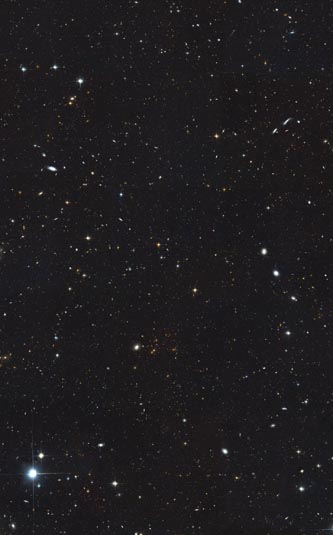
Harvest 50,000 Evolving Galaxies
Description: Optical Survey
Position (J2000): R.A. 14h 17m Dec. +52° 30'
Constellation: Ursa Major
Dimensions: The Extended Groth Strip is 1.1 degrees long by 0.15 degrees wide (70.5 x 10.1 arcminutes, respectively).
Exposure Date(s): June, 2004 - March, 2005
Exposure Time: 3.2 days (76 hours)
Image Credit: NASA, ESA, M. Davis (Univ. of California, Berkeley), S. Faber (Univ. of California, Santa Cruz), and A. Koekemoer (STScI)
Release Date: March 6, 2007
ABOUT THIS IMAGE:
This image, taken by NASA's Hubble Space Telescope, represents a small section of a larger panoramic view of the heavens, where at least 50,000 galaxies reside.
The cosmic tapestry unveils galaxies in all shapes, sizes, and colors. Some of the galaxies are nearby; the smaller ones are far away and existed when the universe was only a small fraction of its current age of roughly 14 billion years.
The Hubble observation, made with the Advanced Camera for Surveys, is part of the All-wavelength Extended Groth Strip International Survey, a collaborative effort using major ground-based and space-based telescopes to focus on a narrow swath of sky near the Big Dipper. The region offers a clear view of the distant universe.
Astronomers studying the Groth Strip find that star formation is largely driven by the supply of raw materials, such as gas and dust, collapsing under the force of gravity. More massive galaxies form stars early, whereas the smaller galaxies create their stars over longer timescales. Both normal-looking, undisturbed galaxies and those showing signs of catastrophic collisions were forming an abundance of stars 8 billion years ago. This evidence suggests that violent galaxy mergers were not required for rapid star formation.
The Groth Strip is an extension of an original survey of part of the same region executed in 1994 by Princeton University astronomer Edward J. Groth, who created a mosaic of 28 overlapping fields with the Hubble Wide Field Planetary Camera 2.
The
Advanced Camera for Surveys image was taken from June 2004 to March 2005.
This image is a composite of many separate exposures made by the WFPC2
instrument on the Hubble Space Telescope using two different filters to
sample broad wavelength ranges. The color results from assigning different
hues (colors) to each monochromatic image. In this case, the assigned
colors are:
F606W (V)
blue
F555W (V)
+ F814W (I) green
F814W (I)
red
NOTE: This image
represents the uncropped Hubble release and because of the nature of the
image, larger print sizes will reveal more detail